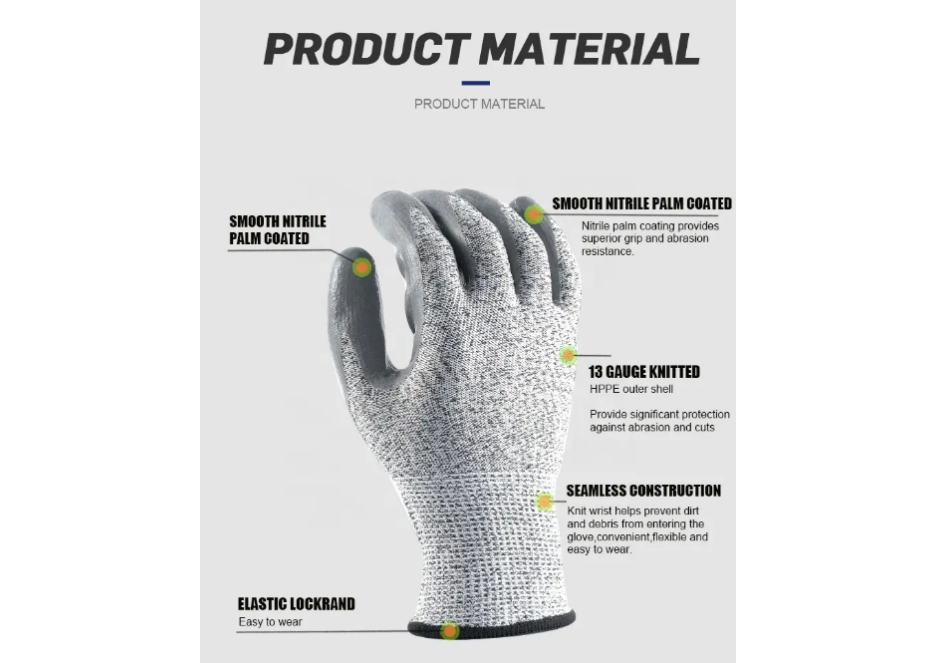What is HPPE and its role in cut resistant gloves?

HPPE, or High-Performance Polyethylene, plays a crucial role in making cut-resistant gloves more durable and protective. But what exactly is it, and how does it enhance glove performance? In this post, we dive into the unique features of HPPE, its comparison with other materials, and its role in industrial safety.
HPPE is a lightweight, durable material that improves the cut resistance of gloves without sacrificing comfort. It enhances protection in hazardous work environments by offering high-performance resistance against cuts and abrasions.
As we explore HPPE’s advantages in gloves, we’ll also look at what makes cut-resistant gloves truly effective and how safety standards shape their design. Read on to find out more.
What is HPPE in gloves?
HPPE stands for High-Performance Polyethylene, a synthetic fiber known for its exceptional strength and durability. It is a key component in many cut-resistant gloves used in industries like construction, manufacturing, and glass handling.
HPPE is a fiber made from polyethylene that offers high tensile strength, making it a popular choice for cut-resistant gloves. Its light weight and flexibility make it ideal for protective hand gear.

HPPE fibers are woven tightly into gloves to create a strong barrier against sharp objects. Its high strength-to-weight ratio ensures that the gloves are not bulky or restrictive, offering workers better dexterity without compromising protection. Unlike other materials, HPPE maintains its performance even after prolonged use, offering a cost-effective solution for industries requiring high levels of hand protection.
What makes cut resistant gloves cut-resistant?
The effectiveness of cut-resistant gloves lies in the materials used and the construction of the glove itself. HPPE is one of the top fibers used in these gloves, but other factors contribute to their overall cut resistance.
Cut-resistant gloves rely on a combination of materials like HPPE, fiberglass, and steel to offer protection. Their design also includes layered constructions that increase durability.
The strength of a cut-resistant glove is determined by the material's ability to resist punctures or abrasions. HPPE fibers, along with materials like Kevlar and fiberglass, are tightly woven to create a mesh that significantly increases resistance to sharp objects. The level of cut protection can vary, depending on the density of the weave and the types of materials used. Many gloves also undergo additional treatments like nitrile coatings for enhanced grip and durability in various environments.
What is the EN standard for cut resistant gloves?
The EN standards for cut-resistant gloves set guidelines for assessing their protective qualities. These standards ensure that gloves meet safety requirements across different industries and environments.
The EN standard (specifically EN 388) measures the cut resistance of gloves on a scale of 1 to 5. This ensures gloves meet industry safety protocols for various tasks.
EN 388 is the European standard used to test gloves for abrasion, cut, tear, and puncture resistance. For cut resistance, a glove is subjected to a blade test, where the number of cycles it takes for the blade to cut through the material determines its rating. Gloves rated 5 offer the highest level of cut resistance, while those rated 1 provide minimal protection. These standards help manufacturers design gloves that balance cut resistance with comfort and dexterity, making them suitable for diverse industrial applications.
Is HPPE Kevlar?
While HPPE and Kevlar are both used in cut-resistant gloves, they are distinct materials with different properties. Many people wonder if HPPE is the same as Kevlar due to their similar applications.
HPPE and Kevlar are both high-performance fibers used in protective gloves, but they differ in composition and specific uses. HPPE is stronger and lighter, while Kevlar excels in heat resistance.
Kevlar, a brand name for para-aramid fibers, is known for its exceptional heat resistance and toughness. It is often used in applications like bulletproof vests and high-heat environments. On the other hand, HPPE, made from polyethylene, offers excellent cut resistance and is lighter and more flexible than Kevlar. While both materials provide superior protection, HPPE is more cost-effective and often used for gloves in industries where high cut resistance is needed without the need for heat resistance. The combination of both materials in some gloves offers a versatile solution for different work environments.
Conclusion
HPPE’s role in cut-resistant gloves is crucial for enhancing protection and comfort. Combined with other materials, it creates gloves that meet rigorous safety standards, ensuring workers’ hands stay protected in dangerous environments.
